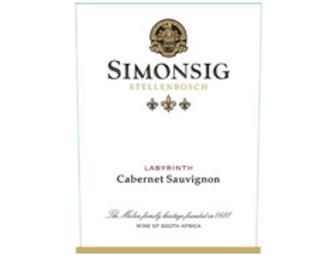Simonsig Labyrinth Cabernet Wine

Item Number: 290
Time Left: CLOSED
Description
In this instance, co-owner Pieter Malan says that if you’ve walked their labyrinth and later drink the Simonsig Labyrinth cabernet sauvignon (to be released in a few years for a children’s charity auction), it implies that you have passed every vine that contributed to the wine in your glass.The labyrinth at Simonsig has a diameter of 35.6 metres, comprising 350 vines planted to a length of 420 metres.
About the Wine:
King of Red
Many refer to Cabernet Sauvignon as the king of red grapes. Perhaps that title is due to its ability to grow worldwide in a number of climates, or to the fact that it produces wine with such character yet such diversity. Either way, this grape is responsible, as a whole or a partner, for some of the greatest wines in the world. In Bordeaux Cabernet Sauvignon is the principle grape of the Medoc. It plays a supporting role in the blends of the right bank in regions such as St-Emillion and Pomerol. Most of the classic and cult wines of Napa Valley are made with Cabernet Sauvignon.
Notable Facts
The Cabernet Sauvignon grape is a small berry with a thick skin, giving it a high solid to juice ratio and creating a wine high in color, tannin and extract. Some typical Cabernet Sauvignon descriptors are cassis, cedar and currant. Because the grape adapts to so many different soils and climates and can flourish with different types of winemaking, its characteristics are different depending on its origin. In Bordeaux you'll find more of the earthy, tannic side of Cabernet. It's almost always blended in Bordeaux, using other grapes to soften the tannins and add complexity. In warmer regions like California and Australia, you'll frequently get more ripe fruit flavors upfront. Grapes are picked when higher in fruit and lower in acid, often giving a more approachable wine. Cabernet Sauvignon grows almost everywhere, many regions using it to blend with ind igenous varieties. As a blending grape it adds structure and tannins.
Summing it up
Successful Sites:
Just about everywhere, particularly Bordeaux and California
Common Descriptors:
black currant, cassis, herbs, cedar, tobacco, earth
Special Instructions
Three bottles of Simonsig Labyrinth 2004 Cabernet Sauvignon at a value of $120 which includes shipping within the US.